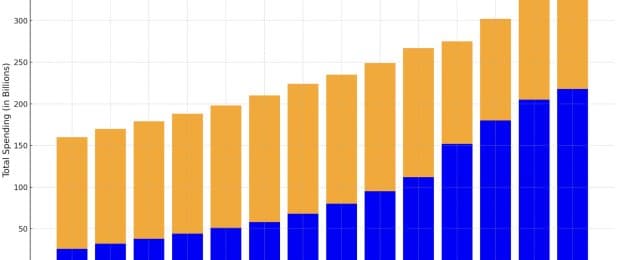The Shift in Advertising: A Deep Dive into the Growth of Digital Marketing Spend (2010-2023)
The world of advertising has undergone a dramatic transformation over the last decade. The chart above illustrates this evolution, highlighting the growth in digital and non-digital advertising spending in the United States from 2010 to 2023. As we look at this data, it’s clear that digital marketing has not only caught up with but has also significantly surpassed non-digital marketing in recent years. This shift signals a broader change in how businesses reach and engage with consumers.
The Early 2010s: Digital vs. Non-Digital Spend
In the early 2010s, non-digital advertising dominated the landscape. Traditional forms of advertising, such as print, radio, and television, were the primary channels through which brands communicated their messages to consumers. During this period, digital marketing was in its nascent stages, with many businesses only beginning to experiment with online channels.
As seen in the chart, digital spending represented a relatively small portion of the total advertising budget in 2010. However, even at this early stage, there was a noticeable year-on-year increase in digital advertising spend, indicating the beginning of a significant trend.
The Mid-2010s: The Digital Revolution
As the decade progressed, the pace of digital adoption accelerated. By 2015, digital advertising had firmly established itself as a key component of marketing strategies across industries. The growing popularity of social media platforms, search engines, and the proliferation of smartphones fueled this shift. Businesses realized that digital channels offered unprecedented targeting capabilities, real-time analytics, and a direct line to consumers, making them more efficient and effective than traditional media.
During this period, we can observe a steady rise in digital advertising spend, while non-digital spending began to plateau. The gap between the two, though still significant, was narrowing, signaling the beginning of a major shift in the advertising paradigm.
The Late 2010s to Early 2020s: Digital Takes the Lead
The latter half of the decade saw digital advertising spending surpass non-digital for the first time. This shift was driven by several factors, including the explosive growth of e-commerce, the increased consumption of digital content, and the maturation of digital advertising technologies such as programmatic buying and AI-driven ad targeting.
The data from 2019 onwards is particularly striking. By 2020, digital advertising had firmly taken the lead, accounting for a larger share of total advertising spend than its non-digital counterpart. The COVID-19 pandemic further accelerated this trend, as businesses were forced to pivot to online channels in response to lockdowns and changes in consumer behavior.
2023 and Beyond: The Future of Advertising
By 2023, the chart shows that digital advertising spending has reached unprecedented levels, dwarfing non-digital spending. This trend is likely to continue as more businesses embrace digital-first strategies, and as emerging technologies such as virtual reality (VR), augmented reality (AR), and artificial intelligence (AI) create new opportunities for engaging consumers.
Moreover, as privacy regulations and changes in consumer behavior continue to evolve, the digital advertising landscape will also undergo further changes. Marketers will need to adapt by finding new ways to leverage data, personalize their messaging, and create meaningful connections with their audiences.
According to the 2023 IAB Internet Advertising Revenue Report, digital advertising revenues reached a record high of $225 billion, marking a 7.3% year-over-year increase. This growth underscores the continued dominance of digital channels, especially in areas like connected TV, social media, and retail media
(https://www.iab.com/news/2023-u-s-digital-advertising-industry-hits-new-record-according-to-iabs-annual-internet-advertising-revenue-report/).
Conclusion
The chart vividly illustrates the dramatic rise of digital marketing over the past decade. What began as a small slice of the advertising pie has grown into the dominant force in the industry. For businesses, this means that investing in digital advertising is no longer optional—it’s essential for staying competitive in today’s market. As we move forward, the ability to effectively navigate the digital landscape will be crucial for brands looking to thrive in an increasingly connected world.
This shift also presents exciting opportunities for innovation in how businesses reach and engage their audiences. The future of advertising is digital, and those who embrace this reality will be well-positioned for success in the years to come.
Take Your Digital Marketing to the Next Level with 561 Media
As digital advertising continues to outpace traditional methods, now is the perfect time to invest in a robust digital marketing strategy. 561 Media offers expert solutions tailored to your business needs, ensuring you stay ahead of the competition in this rapidly evolving landscape.
Whether you need help with SEO, social media, or comprehensive digital campaigns, our experienced team is here to assist. Don’t miss out on the digital revolution—contact 561 Media today and let’s grow your business together.


